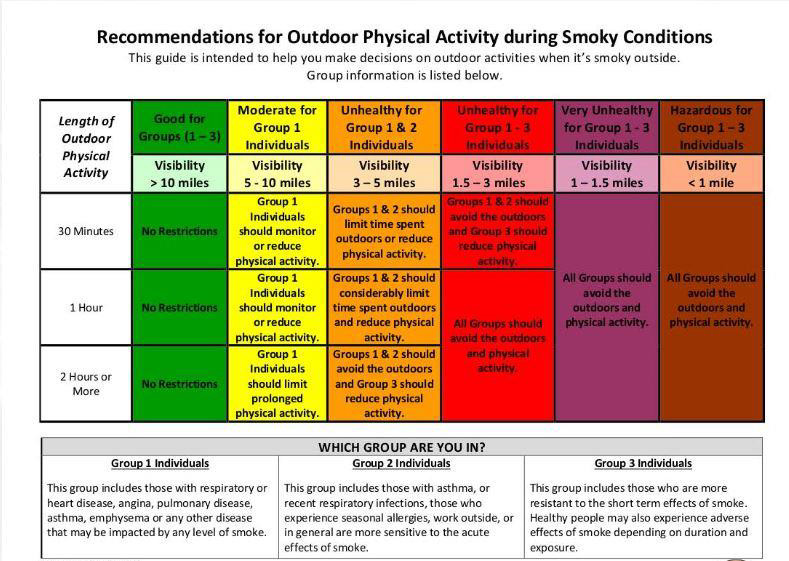San Andreas, CA…The Calaveras County Health Officer and Calaveras County Air Pollution Control District are issuing a current joint air quality advisory to notify the public of the potential for poor air quality conditions primarily due to smoke from the Caldor Fire in El Dorado County, the Dixie Fire in Plumas County, the Airola Fire in Calaveras County near Vallecito, the Washington Fire in Tuolumne County, and several other fires burning in Northern California. This extended advisory shall remain in effect until Monday, August 30, 3:00 PM and may be further extended depending on conditions. Smoke concentrations will vary across the county and may be severe in multiple locations over several days.
Impacts from smoke may affect all areas of Calaveras County from the lower foothills up into the High Country area, dependent upon wind direction, until the fires are extinguished. Shifting overnight winds may cause sudden increases of smoke concentration while asleep. Consider keeping the windows closed to keep out smoky air. A high pressure ridge in the atmosphere and expected lighter winds may hold smoke in the area for several days.
Smoke contains very tiny particles that can be inhaled deep into the lungs. Wildfire smoke can irritate your lungs, cause inflammation, affect your immune system, and make you more prone to lung infections. Symptoms may include, but are not limited to, coughing, watery and itchy eyes, headache, scratchy throat, and difficulty in breathing.
“If you can see or smell smoke, try and avoid unnecessary outdoor activities. Poor air quality caused by the nearby fires can lead to health problems especially for those at increased risk which include people with chronic health conditions, those over 65 years old, and those who have or those who are recovering from COVID-19,” said Dr. Rene Ramirez, Calaveras County Health Officer. “People at higher risk should take steps to lessen their exposure to smoky air,” he added. Consider taking any or all of the following steps to reduce your exposure to smoke.
1. Find out what the air quality is in your area
Use the information about how far you can see (visibility) found in the table at the end of this advisory to estimate the air quality.
Go to fire.airnow.gov. This EPA website is the most accurate source of verified air quality data.
Check purpleair.com. This site provides real-time data for locations around the county.
Keep in mind that air quality can change rapidly at different times during the day due to wind shifts; therefore, it is important to monitor the smoke throughout the day in your area and make outdoor plans accordingly.
2. Limit your exposure to smoke Limit outdoor exertion and physical activity
Stay indoors with the windows and doors closed, if possible
Reduce unnecessary driving. If traveling through smoke-impacted areas, be sure that your vehicle’s ventilation system is on recirculate
3. Don’t let smoke indoors
Keep doors and windows closed.
Eliminate drafts such as through pet doors. Place towels at the base of all substantial gaps under doors. Consider sealing with plastic sheeting any especially leaky windows. Open fireplaces may also need to be sealed with plastic.
Run your air-conditioner only if it does not bring smoke in from the outdoors. Change the standard air conditioner filter to a medium or high efficiency filter if your HVAC can support it (MERV 13). If available, use the recirculate or recycle setting on the unit.
Whenever you can, use air conditioners, fans, and window shades to keep your cleaner air space comfortably cool on hot days. Don’t use a window fan to bring in outside air.
4. Clean your indoor air
Avoid activities that create more indoor and outdoor air pollution, such as smoking, frying foods, sweeping, and vacuuming.
Use a portable air cleaner in one or more rooms. Portable air cleaners work best when run continuously with doors and windows closed.
If you don’t own an air purifier, a Do It Yourself air filter can be made by attaching a 20” x 20” house filter rated at MERV 13 to the back of a 20” box fan. Instructions for building these can be found at https://ema.calaverasgov.us/Air-Pollution-Control/Wildfire-Smoke-Information Sensitive individuals should consider making one room in the house more protected. It is easier to clean the air in one room than it is to clean the air in the whole house.
Get a COVID-19 vaccine as soon as you can. COVID-19 vaccines help protect you from getting sick or severely ill with COVID-19 and may also protect people around you, especially when physical distancing is difficult. Congested lung problems can be made worse by smoke exposure. 4. Wear a mask if smoke exposure is unavoidable.
Cloth masks that are used to slow the spread of COVID-19 by blocking respiratory droplets offer little protection against wildfire smoke. They might not catch small, harmful particles in smoke that can harm your health. N95 and KN95 respirators can provide protection from wildfire smoke. Tiny smoke particles can build up in the lungs over time, even in healthy people. It can be difficult for the lungs to expel these inhaled particles. N95 and KN95 masks, worn properly (not leaking around the edges), can help prevent this buildup. Always wear a N95 or KN95 mask when exposed to very unhealthy or hazardous air quality. Consider wearing these masks for any smoke exposure.
While people may experience varying degrees of symptoms, some people are at greater risk of harmful health effects from wildfire smoke such as:
Children under 18 years of age
Adults aged 65 and older
Pregnant women
People with chronic health conditions such as heart or lung disease, asthma, and diabetes
People who work outdoors
People who are immunocompromised or taking drugs that suppress the immune system
People who currently have or who are recovering from COVID-19
Anyone experiencing serious symptoms due to smoke should contact a health professional. Persons who have a respiratory-related illness may also wish to consult their health care provider if they are experiencing smoke exposure.
The Calaveras County Air Pollution Control District will continue monitoring the air quality in the county and will provide additional advisories as air quality conditions evolve.
Use the chart above as a guideline for outdoor activities. The distance you can see (visibility) can be an indicator of how concentrated the smoke is in your location.
For more information call the Calaveras County Air Pollution Control District at (209) 754-6601 or Calaveras Public Health at (209) 754-6460.



